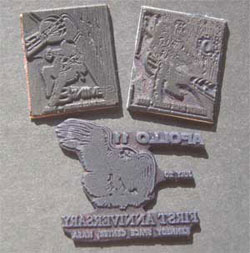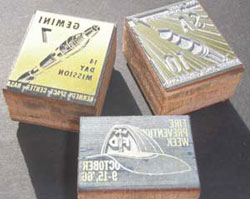 |
| KSC Official 3 months before the Apollo Fire. |
|
They are known by different names, Official NASA Cachets (ONC), KSC Officials and NASA Official Cachets (NOC). They were applied for a decade in Florida to chronicle a golden age of manned space flight from the early Gemini program through the final chapter of Apollo.
Because they represented contemporary artwork applied under the auspices of the Federal Government, KSC Officials have remained popular among general collectors and astrophilatelists alike. Until recently, the whereabouts of the Master Dies has been shrouded in mystery. Now a clearer, but by no means complete, understanding of these rubber stamp masterpieces comes into focus.
 |
| KSC Official with curious multiple impression along the bottom. |
|
In the summer of 1965 Space Coast stamp collectors encouraged NASA to apply a pictorial rubber stamp cachet to envelopes mailed from the Kennedy Space Center. Beginning with the first day of the new post office the illustrations appeared on manned launch dates as well as several other events of local interest.
In many cases several preliminary sketches and essays were created before a final design was selected. Once approved, the finished design was hand engraved into a metal plate. From this it is believed at least two rubber stamps were fashioned. The first, placed in a cancellation machine manufactured by Pitney Bowes (PB) and a second affixed to a wood block with the Master Die on the other side. This second example would be used as a “hand cancel” while the PB rubber stamp would function as the “machine cancel”.
 |
| Well worn PB rubber stamps. |
|
Examination of rubber stamps used in the PB machine suggests considerable wear to the devices. Interestingly, all three show heavy usage. Two, the GT VIII and GT IX, are rarely seen with nice strikes on envelopes while the third, the first anniversary of the Apollo 11 moon landing can often be found with moderate feather detail but virtually absent on the spent rubber stamp. For short runs of several thousand, as was the case for some of the early philatelic requests, expecting a single rubber stamp to last seemed realistic. As the numbers mushroomed, however, would more than one rubber stamp have been procured?
At some point (perhaps included in the “gem” box?) many of the Master Dies passed from post office official to stamp dealer. Some were defaced to prevent subsequent unauthorized use. Others, including the three seen in this article, were not. As mentioned previously, each is a small word block (just slightly larger than the cachet) with the metal Master Die on one side and a rubber stamp on the other.
 |
| Unique hand engraved metal dies with hand rubber stamp on reverse side. |
|
The Master Dies are in remarkably good condition. The metal looks like it was carved yesterday and while the rubber stamps are obviously used they show very little wear as compared to the rubber stamps used in the PB machine. This suggests that a relatively small number of impressions were made by hand cancel.
I am writing a monograph on KSC Officials. Please share high quality scans of rare or unusual Officials. |